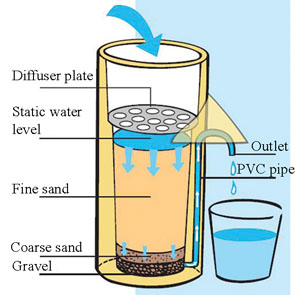14.3.3 Other filtration methods
There are other filtration methods such as ceramic filters and biosand filters that are not currently widely used in Ethiopia but are also appropriate for household and community use.
Micron is another name for the micrometre–which is one millionth of a metre, i.e. a thousandth of a millimetre.
Ceramic filters of various types have been used for water treatment throughout the world. The majority of bacteria are removed mechanically through the filter’s very small (0.6–3.0 microns) pores. Ceramic filters are easy to use, relatively low cost and have a long life if the filter remains unbroken. They are good for reduction of bacteria and protozoa but lack residual protection so recontamination is possible.

Biosand filters differ from the other types of filter described above in that they make use of biological activity as well the mechanical filtering of particles. The most widely used version of the biosand filter is a concrete container about one metre in height and filled with sand (Figure 14.3). The container is filled with water so the water level is above the sand layer. The water allows a ‘bioactive’ layer to grow on top of the sand. This bioactive layer consists of algae, plankton and other microscopic plant life that helps reduce disease-causing organisms, particularly protozoa and bacteria. The biosand filter is fairly easy to use, can be produced from locally available materials, needs little maintenance and has a long life but it has a high initial cost and is difficult to transport. It will improve the look and taste of the water and is good for removing protozoa but has a low rate of virus inactivation and does not remove 100% of bacteria so recontamination is possible.
14.3.2 Cloth filtration
